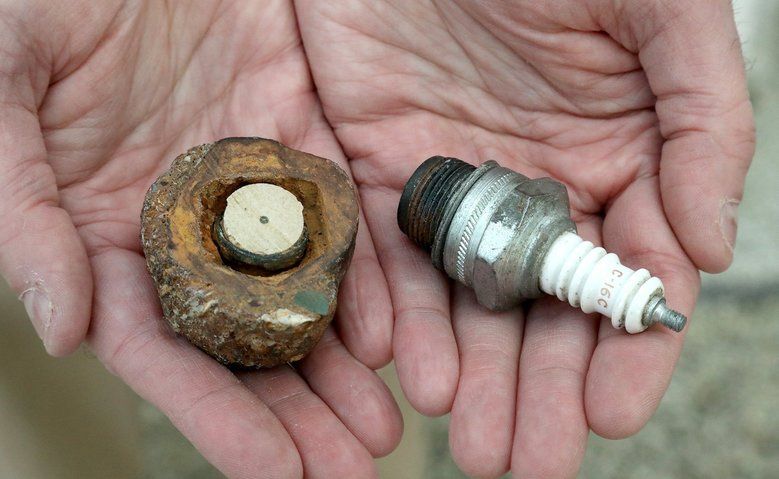Artifact From An Ancient Civilization? The Truth is Out There – in Seattle
by Erik Lacitis December 1, 2018 (seattletimes.com)
• In 1961, a 2×3-inch rock was found in a mountain range near Olancha, California. When split open, a perfectly circular, porcelain-like section containing a tiny pin that responded to a magnet was found inside. An X-ray clearly showed the metal pin with a spring or helix at one end. The other half of the object showed metal covering the porcelain-like cylinder.
• The relic, known as the “Coso Artifact”, is part of a display entitled “What is Reality” at the Pacific Science Center in Seattle, Washington.
• In Erich von Daniken’s latest book, “Impossible Truths: Amazing Evidence of Extraterrestrial Contact”, he writes of the Coso Artifact, “The existence of the pin in an object that is at least 500,000 years old provides evidence of significant knowledge of metallurgy at that time.”
• Enter Pierre Stromberg, a software manager who has spent hundreds of hours researching the Coso Artifact. As a kid, Stromberg read von Daniken’s “Chariots of the Gods?”, which theorizes extraterrestrials influenced early human life. But he lost respect for von Daniken due to his impression that von Daniken would ‘obfuscate’ his assertions. “[S]ome ancient astronaut proponents were not just wrong, they were willfully dishonest,” says Stromberg.
• In 1999, Stromberg contacted the Spark Plug Collectors of America. Club member Chad Windham remembers looking at the X-ray of the Coso Artifact and identified it as a spark plug – a Champion-brand spark plug, in fact – and not half-million year-old extraterrestrial relic. Stromberg thinks that the spark plug may have come from mining equipment.
• Well then, how did a spark plug end up inside a rock? Geologists call it a concretion, when sediment builds up in successive layers around something like a shell or pebble. That’s good enough for Stromberg.
For 57 years, since its discovery by three rockhounds in the mountains of Eastern California, an oblong, 2- by 3-inch stonelike mass has been at the heart of speculation around the world.
Oh, how we want to believe that the truth is out there.
Was it a rock embedded 500,000 years ago with an electronic device left on earth by alien visitors? Or was it the remnant of a long-gone advanced civilization?
Beginning Saturday, you can see it for yourself at the Pacific Science Center.
Why all the speculation?
When the rocklike object was sliced in half shortly after its discovery, a perfectly circular, porcelain-like section was found inside it. In the center of that section was a tiny pin that responded to a magnet.
An X-ray clearly showed the metal pin, with a spring or helix at one end. The other half of the object showed metal covering the porcelain-like cylinder.
How could this technology end up inside such a primeval mass?
It became known as the “Coso Artifact,” after the California mountain range in which it was found.
Like Bigfoot and the Loch Ness Monster, the Coso Artifact became the subject of widespread conjecture and speculation. The advent of the internet put that speculation into hyperdrive.
The Coso Artifact is featured in a YouTube video titled “Top 5 Artifacts That PROVE Past Advanced Civilizations Existed,” which has gotten 2.8 million views.

Enter Pierre Stromberg, a Woodinville software manager, who has spent hundreds of hours researching the artifact. It’s because of his work that the artifact is at the Pacific Science Center as part of a display space titled “What is Reality,” which also includes a walk-through virtual-reality adventure.
The Science Center says the purpose is “to confront a broad variety of mind-bending topics” alongside “scientists and innovators who are shaping the future.”
Stromberg, 54, a 1986 graduate in computer science from Manhattan College in the Bronx, where he grew up, says that as a kid he read Erich von Daniken’s “Chariots of the Gods?”, which theorizes extraterrestrials influenced early human life. Pretty neat stuff, he thought back then.
Stromberg says that in 1977, when he was 13, he lost his admiration for von Daniken after watching a TV interview with the author.
“I was stunned how von Daniken continued to obfuscate and maintain his assertions. I realized that some ancient astronaut proponents were not just wrong, they were willfully dishonest,” says Stromberg. “It really bothered me that I had let myself be influenced by them.”
FAIR USE NOTICE: This page contains copyrighted material the use of which has not been specifically authorized by the copyright owner. ExoNews.org distributes this material for the purpose of news reporting, educational research, comment and criticism, constituting Fair Use under 17 U.S.C § 107. Please contact the Editor at ExoNews with any copyright issue.
